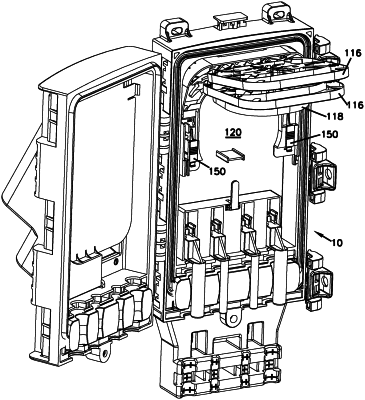| CPC G02B 6/445 (2013.01) [G02B 6/3897 (2013.01); G02B 6/4446 (2013.01); G02B 6/4447 (2013.01); G02B 6/4454 (2013.01)] | 11 Claims |

|
1. An enclosure comprising:
a base defining a splice region;
a cover coupled to the base to move between a closed position and an open position, the cover and the base cooperating to define an interior when the cover is in the closed position, the cover providing access to the interior when in the open position;
a plurality of ruggedized adapters disposed on the cover, each ruggedized adapter having an inner port accessible from an inner side of the cover and an outer port accessible from an outer side of the cover;
at least one removable module disposed at the inner side of the cover, the at least one removable module including a fiber optic splitter, at least one input fiber being routed from the splice region of the base to the at least one removable module, wherein the fiber optic splitter of the at least one removable module is for power-splitting the at least one input fiber into a plurality of splitter output pigtails that have connectorized ends connected to the inner ports of the ruggedized adapters; and
a cable input location for receiving an input cable that includes at least one tube surrounding at least one fiber that carries a same signal as the at least one input fiber being routed from the splice region to the at least one removable module, the input cable being anchored to the base at the cable input location;
wherein the splice region is defined by a flip-tray that is used for splicing the at least one fiber of the input cable to the at least one input fiber that is routed from the splice region to the at least one removable module, the flip-tray defining a cable management portion for routing the at least one fiber of the input cable from the cable input location to the splice region, wherein the enclosure further comprises an additional storage tray disposed underneath the flip-tray that is configured to store an unused fiber of the input cable,
wherein the enclosure includes fiber grow-out zones that are configured to accommodate fiber grow-out resulting from temperature-variation based expansion differences between the at least one fiber and the at least one tube carrying the at least one fiber, wherein a first grow-out zone of the grow-out zones is provided within the storage tray and is formed of at least two deflection walls within the storage tray that cooperatively define a first smaller radius of curvature thereinbetween in combination with a transition section formed of a curved wall that is between the at least two deflection walls that defines a second larger radius of curvature for allowing an expansion area for the at least one fiber, wherein a second grow-out zone is provided by the base of the enclosure and is formed of at least two deflection walls within the base that cooperatively define a first smaller radius of curvature thereinbetween in combination with a transition section formed of a curved wall that is between the at least two deflection walls and that forms a corner of the base of the enclosure that defines a second larger radius of curvature for allowing an expansion area for the at least one fiber.
|